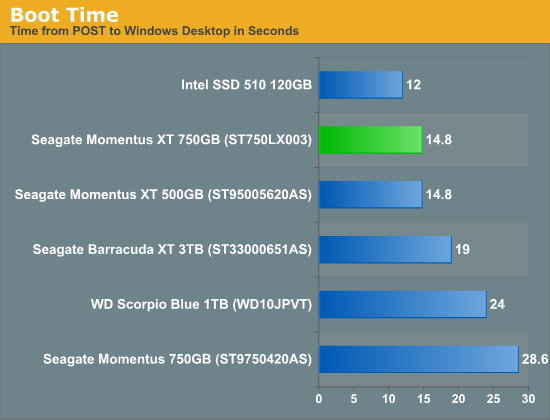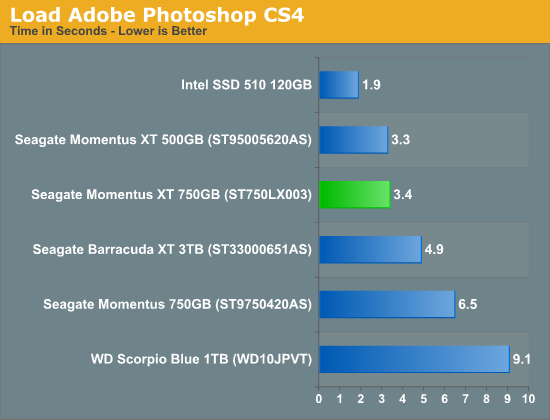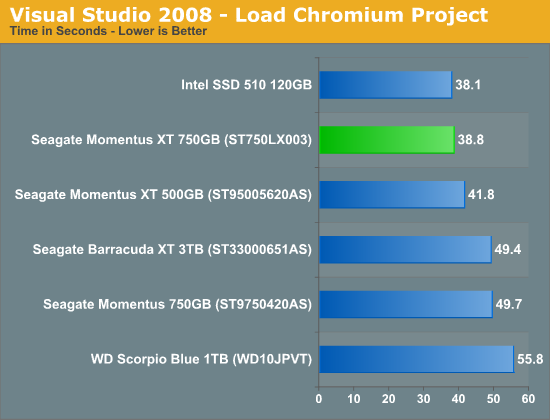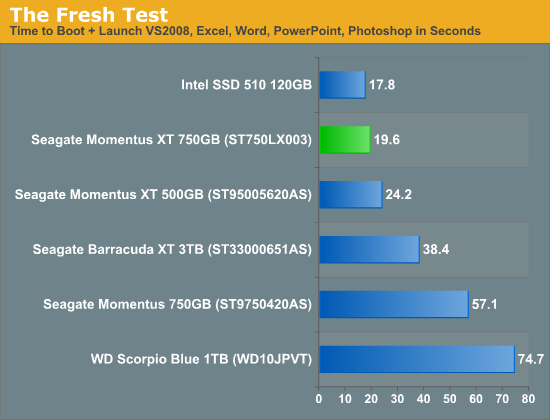Seagate 2nd Generation Momentus XT (750GB) Hybrid HDD Review
by Anand Lal Shimpi on December 13, 2011 12:51 AM EST- Posted in
- Storage
- Seagate
- Momentus XT
- Hybrid Drive
- HDDs
- SSHDs
Once More, With Feeling
Just as we did in our original Momentus XT review, we'll start with a look at some hand-timed application tests.
First up is a good old fashioned boot test. I measured boot time on our testbed from POST to first seeing the mouse cursor on the Windows 7 desktop. This isn't a timing of actual boot-to-use since more loading happens even after you get to the desktop, but it does encapsulate much of the Windows 7 boot process.
All tests were repeated until performance leveled off. In the case of an SSD, this was after just one run. In the case of the 500GB Momentus XT, it took five runs to get there, whereas the second generation model was there after just two. The traditional hard drives each took a few runs for their performance to stabilize as well due to Windows 7's own boot optimizations taking effect.

Boot performance continues to be very impressive on the Momentus XT. It's still not quite as fast as a high end SSD, but it's definitely faster than a traditional hard drive (even a faster, 3.5" model). With a larger NAND cache, your boot time is more likely to remain this low even as other applications and data are pulled into the cache.
Next let's look at a simple application launch test. Adobe Photoshop continues to be one of the more stressful workloads for a hard drive, even down to launching the application. Here I measured from the time I clicked on the Photoshop icon in the Start Menu to first appearance of the blank Photoshop canvas and toolbars. Again, I repeated this test until performance leveled off in all cases.
For the Momentus XT performance fluctuated and it never truly settled on a single launch time. Performance started out at over 5.6 seconds but for all runs after the 2nd launch time ranged in the upper 2s - upper 3s. For its results as well as those from all of the hard drives, I averaged five launch times and presented those averages. The lone SSD in this comparison delivered consistent performance across all runs.

Here the Momentus XT continues to do very well, for a hard drive. It's faster than any of our mechanical drives, and significantly faster than your run-of-the-mill 5400RPM 2.5" drive for sure. A good SSD is still around 70% faster than the Momentus XT.
When constructing our Visual Studio 2008 project build benchmark for our CPU reviews I was reminded just how much of a pain it is to do development work on a system with a hard drive. I tried using the same benchmark to measure drive performance however it seems I used too good of a CPU benchmark as disk performance plays a small role in actual compile time here. Instead I looked at the impact of disk performance on loading the Chromium project in VS2008. I used the same test rules as before, presenting performance once it has leveled off for all drives involved. Once again, the SSD delivered peak performance after a single run. The Momentus XT was able to do it after 2 - 3 runs. Performance didn't improve over multiple runs with the traditional hard drives.

There's a clear division between the NAND equipped Momentus XTs and the traditional hard drives here, but not so much between the former and the Intel SSD 510. I can definitely understand Seagate's temptation to draw the comparison to the performance of an SSD. The problem with doing this is highlighted in my comments above however. While the SSD always performed to the best of its abilities in our tests, regardless of the number of times I ran a test, the Momentus XT needed a couple of runs to get to that point. The NAND cache isn't overly predictive and as a result the first time you do almost anything the Momentus XT will perform like a traditional 7200RPM 2.5" hard drive. Given a light enough workload, the Momentus XT should be able to eventually fit much of the most frequently read data into its cache, but the process of actually getting there can still be painful.
For our last application level benchmark I turn to something I've used since the early days of SSD reviews: the fresh test. Take our boot test from earlier, and string together a series of application launches after you hit the desktop. In this case I'm launching Excel 2007, PowerPoint 2007, Word 2007, Visual Studio 2008 and Photoshop CS4 as soon as the system boots. I measure the time from POST until the last application is completely launched. I call this the fresh test because when you first build a machine everything, even on a traditional hard drive, performs quickly. Load up a lot of applications and use your system for a while and you'll soon notice that things aren't quite as snappy any more. Defragmenting your drive can help but after a certain point it's the bloat of everything installed that really limits performance. A better test would be to use an image that was months (if not years) old, but I've found that this benchmark gets the job done. Lower numbers here translate very well to a snappier system and one that feels new regardless of what you've got loaded on it. SSDs truly excel in the fresh test, but what about the Momentus XT?

Surprisingly enough, the Momentus XT does extremely well. The newer model clearly does a better job of keeping more data in NAND, but both are head and shoulders above the traditional hard drives. If you have a fairly regular usage pattern (E.g. you always run the same 5 or 6 applications), the Momentus XT can significantly improve the overall user experience. In some cases, it can even approach the performance of an SSD.










98 Comments
View All Comments
murakozi - Tuesday, December 13, 2011 - link
I surely hope this iteration of Momentus XT is better than the original. I have had my share of the "performance" of that.Scenario: trying to migrate a WinXP system on a HP6910p from 2,5HDD to Momentus XT. Methods: Arconis, Norton Ghost, complete reinstall.
Result: epic failure. at first boot: sunshine and happyness. Than: BSOD, BSOD, non system disk..., NTFS failure, worse at every restart. Some digging in forums revealed serious issues with some SATA chipsets (note: this is a mainstream notebook, bot some nieche product).
Tried to reuse the drive in a desktop (Dell Optiplex 775), results: the same. A weekend of trial and error, resulting in error.
RMA-d the drive, got a Sandforce SSD instead (128 GB, for additional payment of course), living happily since then.
fuzzymath10 - Tuesday, December 13, 2011 - link
I migrated a Dell D630 from an 80GB X25-M (running out of space) to a 500GB Momentus XT and it worked perfectly on the first try, and has been working ever since.Despite the user not being of the "power" type, the drive has held up well, and I was impressed by how fast it felt in use despite the mess of applications running/installed.
Xajel - Tuesday, December 13, 2011 - link
In Notebooks, some guys need fast hard drive like an SSD but they still need bigger storage space... but the lake of space stops them.. they can't go for desktop like configuration ( SSD for OS, normal HDD for storage & media ) coz of lake of space and slots and weight also...Hybrid thought to be nice and better than regular HDD's but still very far from being SSD class performance...
I'm wondering why not separating the SSD part from the regular HDD part from this hybrid and use a SATA port multiplier to use the single SATA port with two drives but in one physical package... the drive will be normal, like a single platter 500GB drive but will have a port multiplier and an 128GB SSD within the drive... the drive will looks like 2 separated drives to the OS...
we can use SATA 6Gbps and split the bandwidth to 3+3 and still have plenty of bandwidth !!
the concept will be nice but expensive ( SSD + port duplicator + HDD in one package ) but it can do what Hybrids can't...
The only method to do such configuration is to use miniPCIe SSD drives on the laptop along with the regular HDD... but this will be limited to larger size of laptops as some smaller one does't have miniPCIe slot, or have but used by WiFi/Bluetooth module...
DanNeely - Tuesday, December 13, 2011 - link
Physical space constraints most likely, 2.5" HDs don't really have any extra volume to spare. You'd probably need to fall back on 1.8" platters meaning anything not in the SSD would take a large performance hit.freezervv - Tuesday, December 13, 2011 - link
This article is pretty amazing. ;)1) A nice reference to a general form of Amdahl's law
2) Useful "These are how the industry tenets / trends intersect in this product" summary in the video
3) Super sexy mic
4) Lost in Translation quote
As was noted in the article -- this drive isn't as fast as SSDs / high-density disks. Which is to say it's for products that a) require more space than SSDs can cost-effectively provide (so > 120GB) & b) can't physically accommodate 3.5" drives (or arrays thereof).
That's a not insignificant market -- virtually every laptop sold.
--------------------------------------------------------------------------------------
One big question, though, re: moving hybrid technology into the 3.5" form factor:
-- How do you see large, cheap NAND cache being reasonably deployed in the next decade?
From memory, we've currently got the following solutions...
-- Convention HDD buffers (e.g. 64MB)
-- Hybrid drives (similar, except with enough NAND capacity to do heavy predictive caching)
-- Intel Z68-style SRT (SSD in front of a disk array, tied in with chipset)
-- ZFS-style L2ARC / ZIL (same, except via the filesystem)
-- "Install OS to SSD, everything else to HDD" approach
-- Windows 7 SuperFetch
... which all add "memory" between RAM and the disk subsystem. And furthermore, which all try to pretend they're just "faster disk".
The issue, being illustrated by the following pathological (but not completely unreasonable) example:
-- Windows 7, running full SuperFetch
-- in an Intel Z68 SRT system
-- backed by hybrid SSHDDs
Assuming they're all running the same algorithm (or at least a similar one: some mix of locality, frequency, stride pattern, etc.) you could have Win7 caching an address in RAM, Intel caching the same thing to the SSD, and the hybrid drive caching the same thing in its NAND.
Which seems... ... ... "suboptimal"?
freezervv - Tuesday, December 13, 2011 - link
Or I guess, to put it another way, the same problem the IETF people are running into where TCP and large buffers lead to less-than-possible bandwidth.How do you design an oblivious (because we have to support legacy OSs), but still optimal (because we want performance) algorithm when the parts above and below you are in constant flux?
nicwillemse - Tuesday, December 13, 2011 - link
Hi Anand,Thanks for the review! Im currently using the previous verion in my mac with no issues what so ever, do you think I would have problems if I upgraded to the new one ?
poohbear - Tuesday, December 13, 2011 - link
Is this drive $245 due to the Thailand flooding and hdd shortage issue? I can't imagine paying $245 for 750gb HDD & a measly 8gb SSD.Stahn Aileron - Tuesday, December 13, 2011 - link
So I'm guessing with this push for NAND-based storage, we'll start seeing a bigger push for a DRAM Buffer/NAND Cache/Platter Storage scheme versus the current Buffer/Storage scheme?Even Intel is kinda pushing it with their SRT feature on select chipsets.
Anand, do you think we'll see more adoption of this type of technology at the system level (like Intel SRT) or more at the integrated device level (like the Momentus XT here)? Or maybe even integrated at the Motherboard level, perhaps? I don't really it happening at the MB level, since the onus would be on the MB manufacturers to support and validate it.
Also, any thoughts on the future about pure Flash storage versus magnetic storage? We're seeing these enterprise-grade, TB-sized drive available. Do you think hybrid schemes like the Momentus XT or Intel's SRT will make in-roads in that market? I'm curious about the future of storage and whether or not we'll all slowly move to viable all-flash storage mass solutions as flash memory costs drop. This barring any major advance in other longterm storage technologies, like holographic systems.
freezervv - Tuesday, December 13, 2011 - link
Check comments page 2. ;)It really does beg the question...